Project Proposal: Impact of Child Abuse on Mental Health
VerifiedAdded on 2022/09/15
|12
|2335
|27
Project
AI Summary
This project proposal investigates the profound impact of child abuse and neglect on children's mental and behavioral health. It begins by establishing the prevalence and significance of child abuse as a public health concern, highlighting the resulting trauma and its effects on brain development and mental health disorders such as PTSD and depression. The proposal aims to identify effective interventions to improve the stability and mental health of children who are victims of abuse. The project focuses on a music therapy intervention, detailing its implementation within a hospital setting, involving pediatric nurses, mental health professionals, parents, and music experts. The project plan includes primary and secondary objectives, evidence-based interventions, stakeholder roles, ethical considerations, and risk management. The literature review supports the use of music therapy to address the trauma of abuse, while the proposal emphasizes the importance of a holistic approach that includes family involvement and culturally sensitive practices. The project is designed to improve the mental and behavioral health outcomes for children affected by abuse.
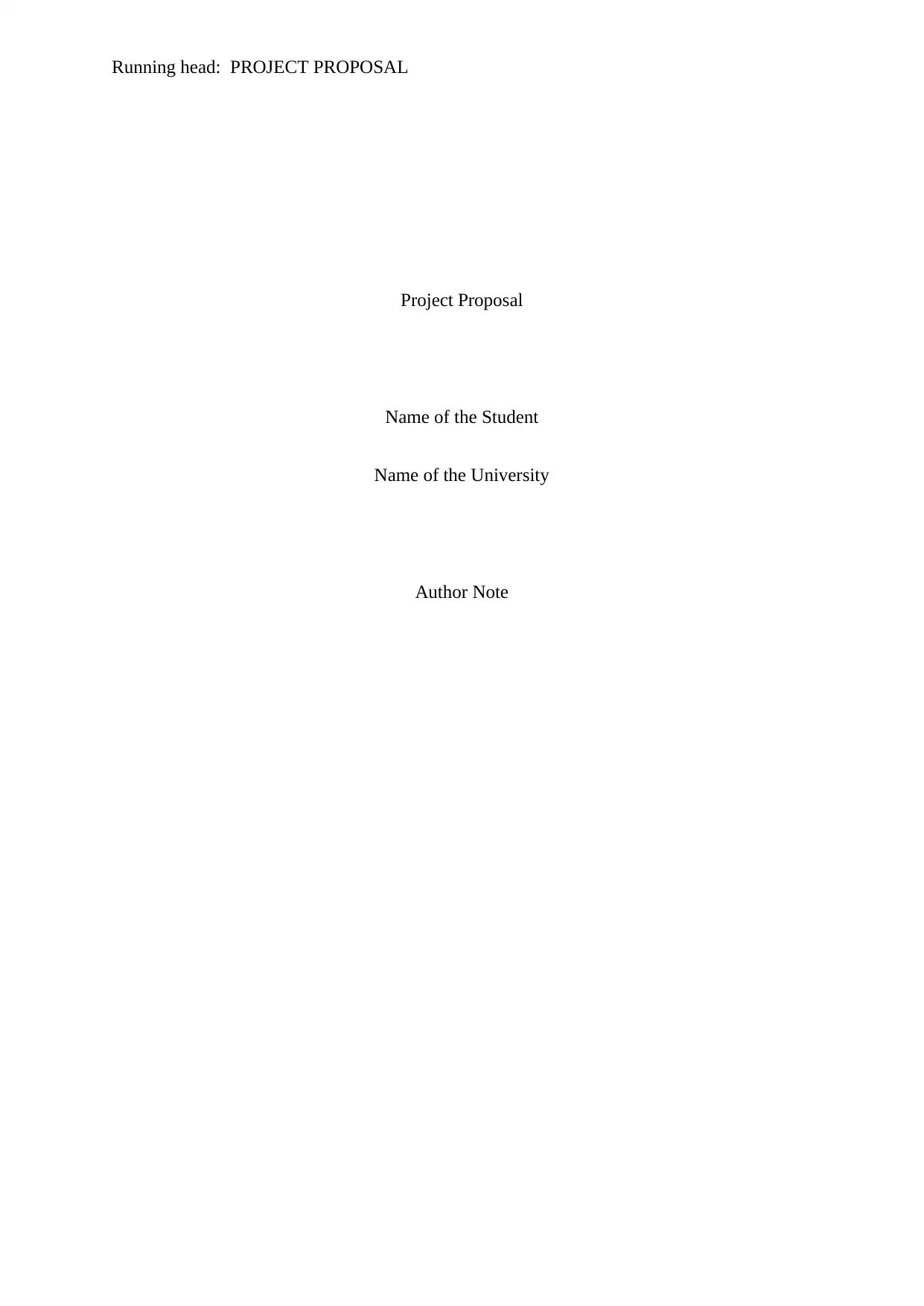
Running head: PROJECT PROPOSAL
Project Proposal
Name of the Student
Name of the University
Author Note
Project Proposal
Name of the Student
Name of the University
Author Note
Paraphrase This Document
Need a fresh take? Get an instant paraphrase of this document with our AI Paraphraser
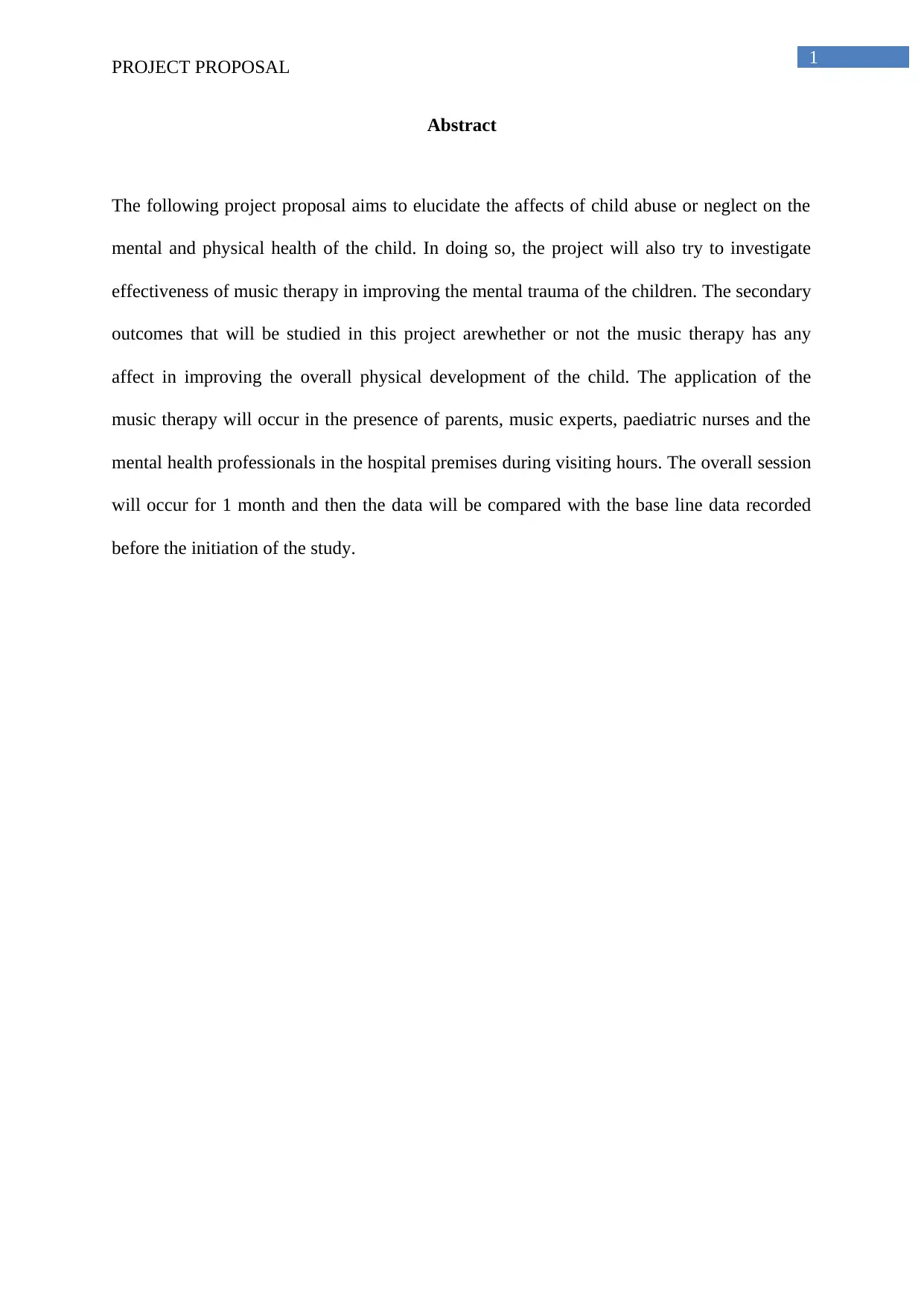
1
PROJECT PROPOSAL
Abstract
The following project proposal aims to elucidate the affects of child abuse or neglect on the
mental and physical health of the child. In doing so, the project will also try to investigate
effectiveness of music therapy in improving the mental trauma of the children. The secondary
outcomes that will be studied in this project arewhether or not the music therapy has any
affect in improving the overall physical development of the child. The application of the
music therapy will occur in the presence of parents, music experts, paediatric nurses and the
mental health professionals in the hospital premises during visiting hours. The overall session
will occur for 1 month and then the data will be compared with the base line data recorded
before the initiation of the study.
PROJECT PROPOSAL
Abstract
The following project proposal aims to elucidate the affects of child abuse or neglect on the
mental and physical health of the child. In doing so, the project will also try to investigate
effectiveness of music therapy in improving the mental trauma of the children. The secondary
outcomes that will be studied in this project arewhether or not the music therapy has any
affect in improving the overall physical development of the child. The application of the
music therapy will occur in the presence of parents, music experts, paediatric nurses and the
mental health professionals in the hospital premises during visiting hours. The overall session
will occur for 1 month and then the data will be compared with the base line data recorded
before the initiation of the study.
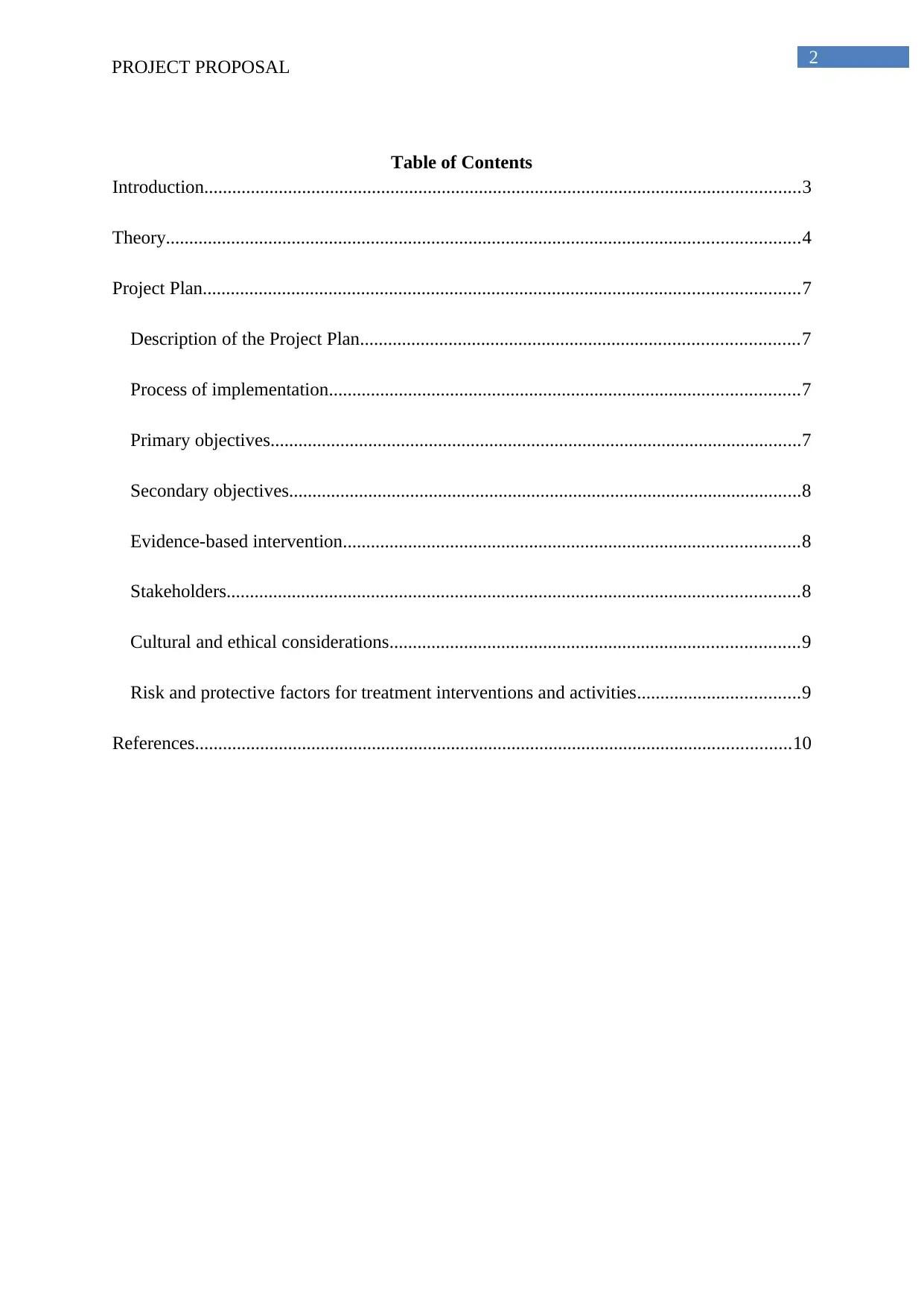
2
PROJECT PROPOSAL
Table of Contents
Introduction................................................................................................................................3
Theory........................................................................................................................................4
Project Plan................................................................................................................................7
Description of the Project Plan..............................................................................................7
Process of implementation.....................................................................................................7
Primary objectives..................................................................................................................7
Secondary objectives..............................................................................................................8
Evidence-based intervention..................................................................................................8
Stakeholders...........................................................................................................................8
Cultural and ethical considerations........................................................................................9
Risk and protective factors for treatment interventions and activities...................................9
References................................................................................................................................10
PROJECT PROPOSAL
Table of Contents
Introduction................................................................................................................................3
Theory........................................................................................................................................4
Project Plan................................................................................................................................7
Description of the Project Plan..............................................................................................7
Process of implementation.....................................................................................................7
Primary objectives..................................................................................................................7
Secondary objectives..............................................................................................................8
Evidence-based intervention..................................................................................................8
Stakeholders...........................................................................................................................8
Cultural and ethical considerations........................................................................................9
Risk and protective factors for treatment interventions and activities...................................9
References................................................................................................................................10
⊘ This is a preview!⊘
Do you want full access?
Subscribe today to unlock all pages.

Trusted by 1+ million students worldwide
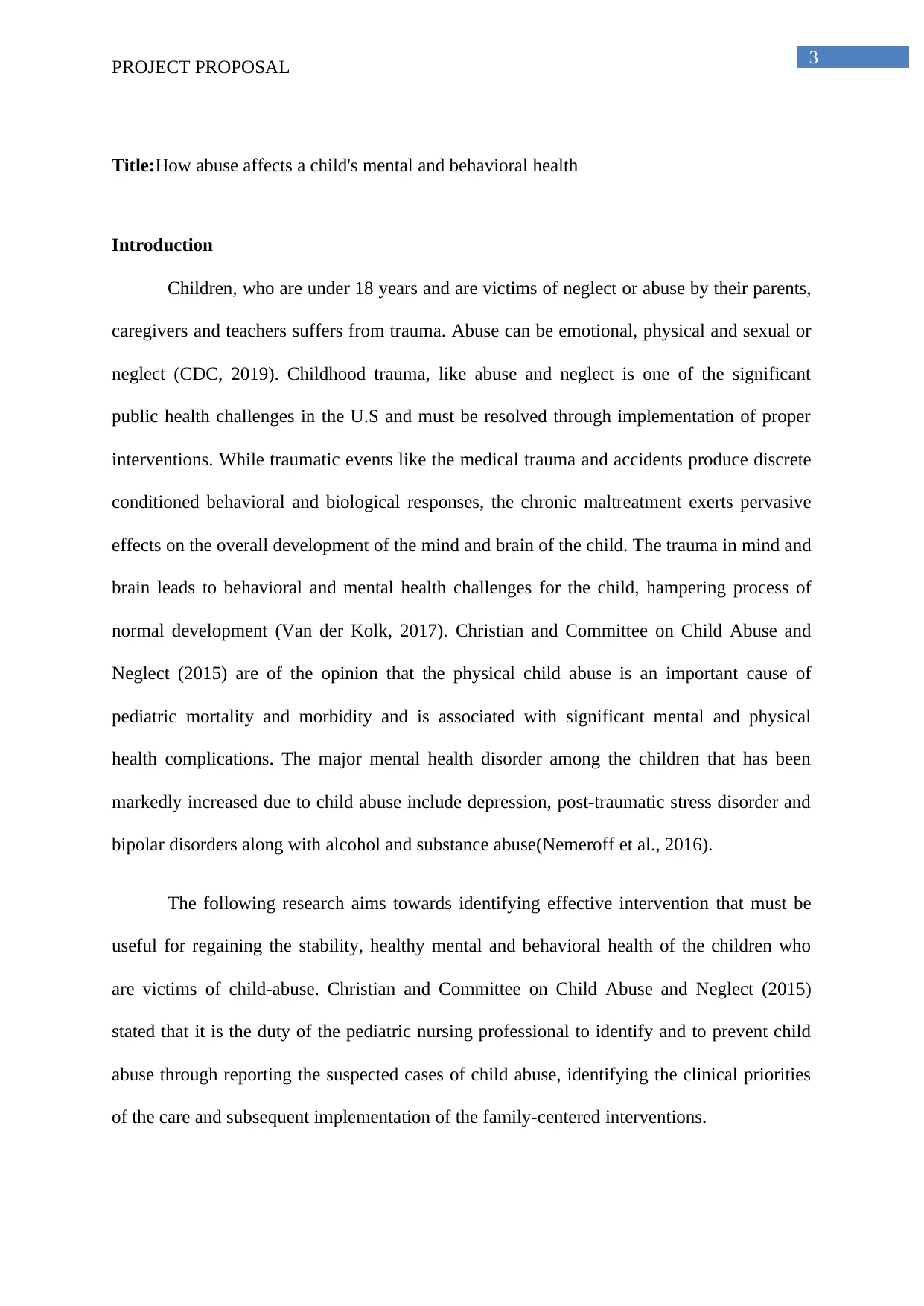
3
PROJECT PROPOSAL
Title:How abuse affects a child's mental and behavioral health
Introduction
Children, who are under 18 years and are victims of neglect or abuse by their parents,
caregivers and teachers suffers from trauma. Abuse can be emotional, physical and sexual or
neglect (CDC, 2019). Childhood trauma, like abuse and neglect is one of the significant
public health challenges in the U.S and must be resolved through implementation of proper
interventions. While traumatic events like the medical trauma and accidents produce discrete
conditioned behavioral and biological responses, the chronic maltreatment exerts pervasive
effects on the overall development of the mind and brain of the child. The trauma in mind and
brain leads to behavioral and mental health challenges for the child, hampering process of
normal development (Van der Kolk, 2017). Christian and Committee on Child Abuse and
Neglect (2015) are of the opinion that the physical child abuse is an important cause of
pediatric mortality and morbidity and is associated with significant mental and physical
health complications. The major mental health disorder among the children that has been
markedly increased due to child abuse include depression, post-traumatic stress disorder and
bipolar disorders along with alcohol and substance abuse(Nemeroff et al., 2016).
The following research aims towards identifying effective intervention that must be
useful for regaining the stability, healthy mental and behavioral health of the children who
are victims of child-abuse. Christian and Committee on Child Abuse and Neglect (2015)
stated that it is the duty of the pediatric nursing professional to identify and to prevent child
abuse through reporting the suspected cases of child abuse, identifying the clinical priorities
of the care and subsequent implementation of the family-centered interventions.
PROJECT PROPOSAL
Title:How abuse affects a child's mental and behavioral health
Introduction
Children, who are under 18 years and are victims of neglect or abuse by their parents,
caregivers and teachers suffers from trauma. Abuse can be emotional, physical and sexual or
neglect (CDC, 2019). Childhood trauma, like abuse and neglect is one of the significant
public health challenges in the U.S and must be resolved through implementation of proper
interventions. While traumatic events like the medical trauma and accidents produce discrete
conditioned behavioral and biological responses, the chronic maltreatment exerts pervasive
effects on the overall development of the mind and brain of the child. The trauma in mind and
brain leads to behavioral and mental health challenges for the child, hampering process of
normal development (Van der Kolk, 2017). Christian and Committee on Child Abuse and
Neglect (2015) are of the opinion that the physical child abuse is an important cause of
pediatric mortality and morbidity and is associated with significant mental and physical
health complications. The major mental health disorder among the children that has been
markedly increased due to child abuse include depression, post-traumatic stress disorder and
bipolar disorders along with alcohol and substance abuse(Nemeroff et al., 2016).
The following research aims towards identifying effective intervention that must be
useful for regaining the stability, healthy mental and behavioral health of the children who
are victims of child-abuse. Christian and Committee on Child Abuse and Neglect (2015)
stated that it is the duty of the pediatric nursing professional to identify and to prevent child
abuse through reporting the suspected cases of child abuse, identifying the clinical priorities
of the care and subsequent implementation of the family-centered interventions.
Paraphrase This Document
Need a fresh take? Get an instant paraphrase of this document with our AI Paraphraser
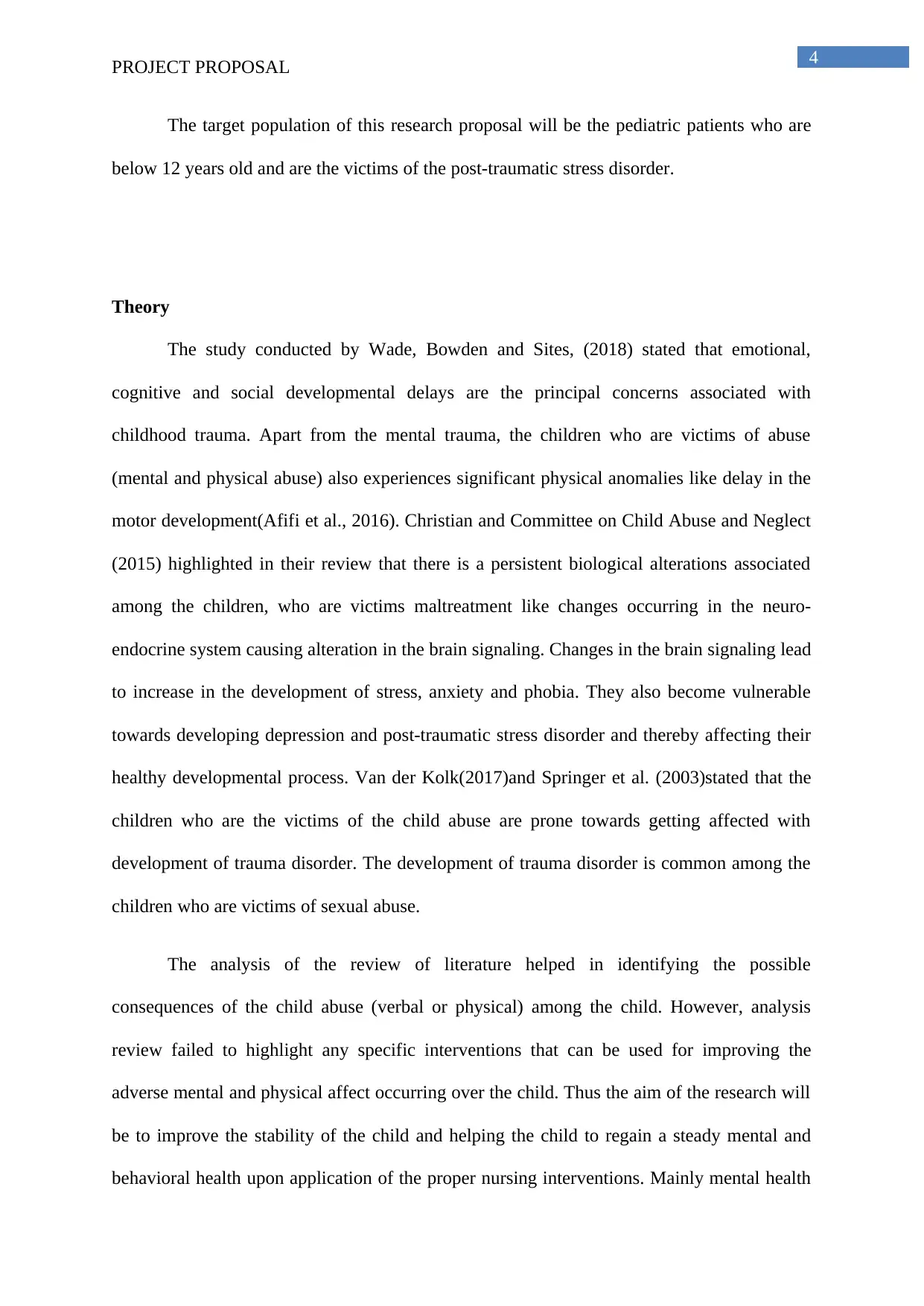
4
PROJECT PROPOSAL
The target population of this research proposal will be the pediatric patients who are
below 12 years old and are the victims of the post-traumatic stress disorder.
Theory
The study conducted by Wade, Bowden and Sites, (2018) stated that emotional,
cognitive and social developmental delays are the principal concerns associated with
childhood trauma. Apart from the mental trauma, the children who are victims of abuse
(mental and physical abuse) also experiences significant physical anomalies like delay in the
motor development(Afifi et al., 2016). Christian and Committee on Child Abuse and Neglect
(2015) highlighted in their review that there is a persistent biological alterations associated
among the children, who are victims maltreatment like changes occurring in the neuro-
endocrine system causing alteration in the brain signaling. Changes in the brain signaling lead
to increase in the development of stress, anxiety and phobia. They also become vulnerable
towards developing depression and post-traumatic stress disorder and thereby affecting their
healthy developmental process. Van der Kolk(2017)and Springer et al. (2003)stated that the
children who are the victims of the child abuse are prone towards getting affected with
development of trauma disorder. The development of trauma disorder is common among the
children who are victims of sexual abuse.
The analysis of the review of literature helped in identifying the possible
consequences of the child abuse (verbal or physical) among the child. However, analysis
review failed to highlight any specific interventions that can be used for improving the
adverse mental and physical affect occurring over the child. Thus the aim of the research will
be to improve the stability of the child and helping the child to regain a steady mental and
behavioral health upon application of the proper nursing interventions. Mainly mental health
PROJECT PROPOSAL
The target population of this research proposal will be the pediatric patients who are
below 12 years old and are the victims of the post-traumatic stress disorder.
Theory
The study conducted by Wade, Bowden and Sites, (2018) stated that emotional,
cognitive and social developmental delays are the principal concerns associated with
childhood trauma. Apart from the mental trauma, the children who are victims of abuse
(mental and physical abuse) also experiences significant physical anomalies like delay in the
motor development(Afifi et al., 2016). Christian and Committee on Child Abuse and Neglect
(2015) highlighted in their review that there is a persistent biological alterations associated
among the children, who are victims maltreatment like changes occurring in the neuro-
endocrine system causing alteration in the brain signaling. Changes in the brain signaling lead
to increase in the development of stress, anxiety and phobia. They also become vulnerable
towards developing depression and post-traumatic stress disorder and thereby affecting their
healthy developmental process. Van der Kolk(2017)and Springer et al. (2003)stated that the
children who are the victims of the child abuse are prone towards getting affected with
development of trauma disorder. The development of trauma disorder is common among the
children who are victims of sexual abuse.
The analysis of the review of literature helped in identifying the possible
consequences of the child abuse (verbal or physical) among the child. However, analysis
review failed to highlight any specific interventions that can be used for improving the
adverse mental and physical affect occurring over the child. Thus the aim of the research will
be to improve the stability of the child and helping the child to regain a steady mental and
behavioral health upon application of the proper nursing interventions. Mainly mental health
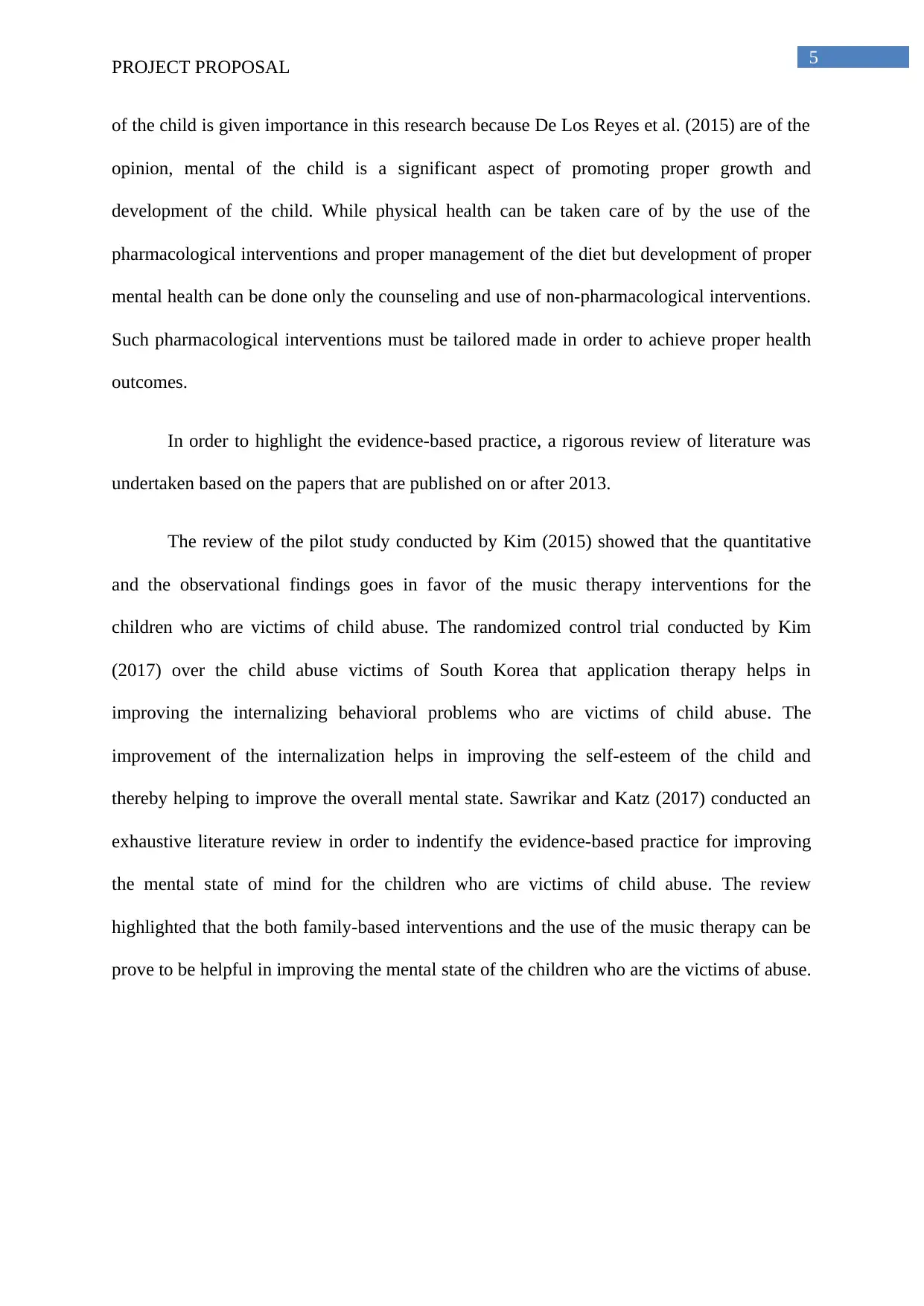
5
PROJECT PROPOSAL
of the child is given importance in this research because De Los Reyes et al. (2015) are of the
opinion, mental of the child is a significant aspect of promoting proper growth and
development of the child. While physical health can be taken care of by the use of the
pharmacological interventions and proper management of the diet but development of proper
mental health can be done only the counseling and use of non-pharmacological interventions.
Such pharmacological interventions must be tailored made in order to achieve proper health
outcomes.
In order to highlight the evidence-based practice, a rigorous review of literature was
undertaken based on the papers that are published on or after 2013.
The review of the pilot study conducted by Kim (2015) showed that the quantitative
and the observational findings goes in favor of the music therapy interventions for the
children who are victims of child abuse. The randomized control trial conducted by Kim
(2017) over the child abuse victims of South Korea that application therapy helps in
improving the internalizing behavioral problems who are victims of child abuse. The
improvement of the internalization helps in improving the self-esteem of the child and
thereby helping to improve the overall mental state. Sawrikar and Katz (2017) conducted an
exhaustive literature review in order to indentify the evidence-based practice for improving
the mental state of mind for the children who are victims of child abuse. The review
highlighted that the both family-based interventions and the use of the music therapy can be
prove to be helpful in improving the mental state of the children who are the victims of abuse.
PROJECT PROPOSAL
of the child is given importance in this research because De Los Reyes et al. (2015) are of the
opinion, mental of the child is a significant aspect of promoting proper growth and
development of the child. While physical health can be taken care of by the use of the
pharmacological interventions and proper management of the diet but development of proper
mental health can be done only the counseling and use of non-pharmacological interventions.
Such pharmacological interventions must be tailored made in order to achieve proper health
outcomes.
In order to highlight the evidence-based practice, a rigorous review of literature was
undertaken based on the papers that are published on or after 2013.
The review of the pilot study conducted by Kim (2015) showed that the quantitative
and the observational findings goes in favor of the music therapy interventions for the
children who are victims of child abuse. The randomized control trial conducted by Kim
(2017) over the child abuse victims of South Korea that application therapy helps in
improving the internalizing behavioral problems who are victims of child abuse. The
improvement of the internalization helps in improving the self-esteem of the child and
thereby helping to improve the overall mental state. Sawrikar and Katz (2017) conducted an
exhaustive literature review in order to indentify the evidence-based practice for improving
the mental state of mind for the children who are victims of child abuse. The review
highlighted that the both family-based interventions and the use of the music therapy can be
prove to be helpful in improving the mental state of the children who are the victims of abuse.
⊘ This is a preview!⊘
Do you want full access?
Subscribe today to unlock all pages.

Trusted by 1+ million students worldwide
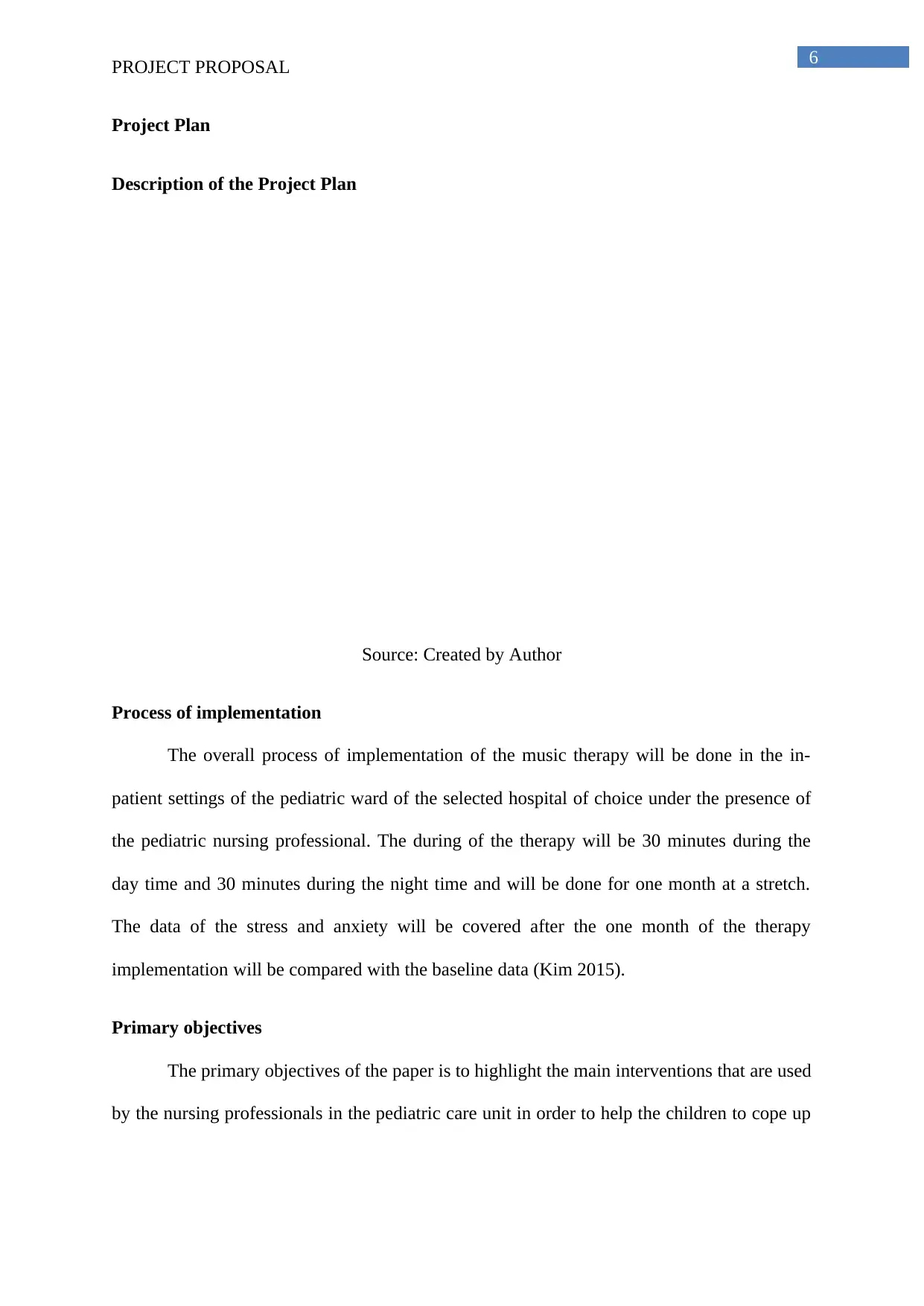
6
PROJECT PROPOSAL
Project Plan
Description of the Project Plan
Source: Created by Author
Process of implementation
The overall process of implementation of the music therapy will be done in the in-
patient settings of the pediatric ward of the selected hospital of choice under the presence of
the pediatric nursing professional. The during of the therapy will be 30 minutes during the
day time and 30 minutes during the night time and will be done for one month at a stretch.
The data of the stress and anxiety will be covered after the one month of the therapy
implementation will be compared with the baseline data (Kim 2015).
Primary objectives
The primary objectives of the paper is to highlight the main interventions that are used
by the nursing professionals in the pediatric care unit in order to help the children to cope up
PROJECT PROPOSAL
Project Plan
Description of the Project Plan
Source: Created by Author
Process of implementation
The overall process of implementation of the music therapy will be done in the in-
patient settings of the pediatric ward of the selected hospital of choice under the presence of
the pediatric nursing professional. The during of the therapy will be 30 minutes during the
day time and 30 minutes during the night time and will be done for one month at a stretch.
The data of the stress and anxiety will be covered after the one month of the therapy
implementation will be compared with the baseline data (Kim 2015).
Primary objectives
The primary objectives of the paper is to highlight the main interventions that are used
by the nursing professionals in the pediatric care unit in order to help the children to cope up
Paraphrase This Document
Need a fresh take? Get an instant paraphrase of this document with our AI Paraphraser
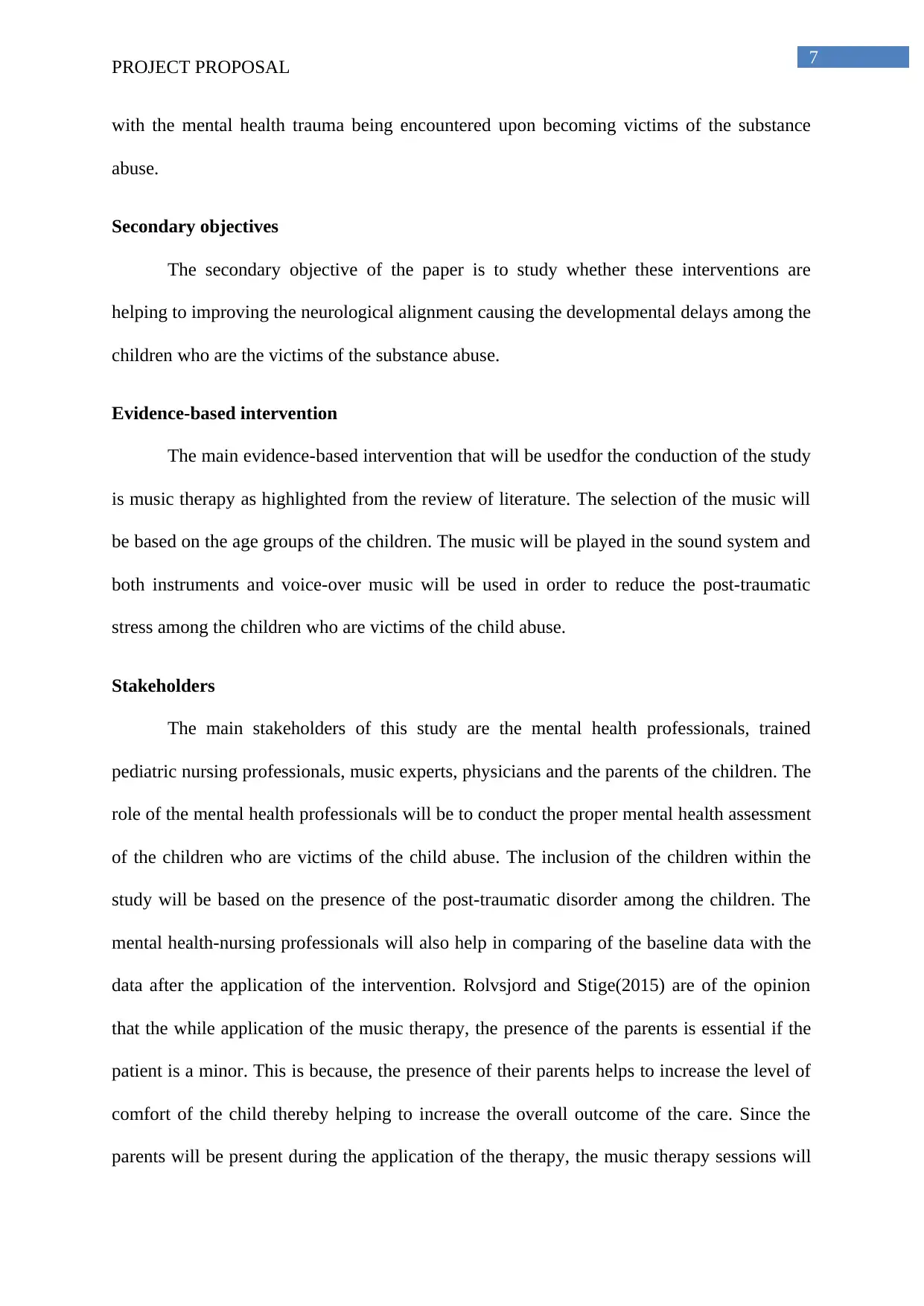
7
PROJECT PROPOSAL
with the mental health trauma being encountered upon becoming victims of the substance
abuse.
Secondary objectives
The secondary objective of the paper is to study whether these interventions are
helping to improving the neurological alignment causing the developmental delays among the
children who are the victims of the substance abuse.
Evidence-based intervention
The main evidence-based intervention that will be usedfor the conduction of the study
is music therapy as highlighted from the review of literature. The selection of the music will
be based on the age groups of the children. The music will be played in the sound system and
both instruments and voice-over music will be used in order to reduce the post-traumatic
stress among the children who are victims of the child abuse.
Stakeholders
The main stakeholders of this study are the mental health professionals, trained
pediatric nursing professionals, music experts, physicians and the parents of the children. The
role of the mental health professionals will be to conduct the proper mental health assessment
of the children who are victims of the child abuse. The inclusion of the children within the
study will be based on the presence of the post-traumatic disorder among the children. The
mental health-nursing professionals will also help in comparing of the baseline data with the
data after the application of the intervention. Rolvsjord and Stige(2015) are of the opinion
that the while application of the music therapy, the presence of the parents is essential if the
patient is a minor. This is because, the presence of their parents helps to increase the level of
comfort of the child thereby helping to increase the overall outcome of the care. Since the
parents will be present during the application of the therapy, the music therapy sessions will
PROJECT PROPOSAL
with the mental health trauma being encountered upon becoming victims of the substance
abuse.
Secondary objectives
The secondary objective of the paper is to study whether these interventions are
helping to improving the neurological alignment causing the developmental delays among the
children who are the victims of the substance abuse.
Evidence-based intervention
The main evidence-based intervention that will be usedfor the conduction of the study
is music therapy as highlighted from the review of literature. The selection of the music will
be based on the age groups of the children. The music will be played in the sound system and
both instruments and voice-over music will be used in order to reduce the post-traumatic
stress among the children who are victims of the child abuse.
Stakeholders
The main stakeholders of this study are the mental health professionals, trained
pediatric nursing professionals, music experts, physicians and the parents of the children. The
role of the mental health professionals will be to conduct the proper mental health assessment
of the children who are victims of the child abuse. The inclusion of the children within the
study will be based on the presence of the post-traumatic disorder among the children. The
mental health-nursing professionals will also help in comparing of the baseline data with the
data after the application of the intervention. Rolvsjord and Stige(2015) are of the opinion
that the while application of the music therapy, the presence of the parents is essential if the
patient is a minor. This is because, the presence of their parents helps to increase the level of
comfort of the child thereby helping to increase the overall outcome of the care. Since the
parents will be present during the application of the therapy, the music therapy sessions will
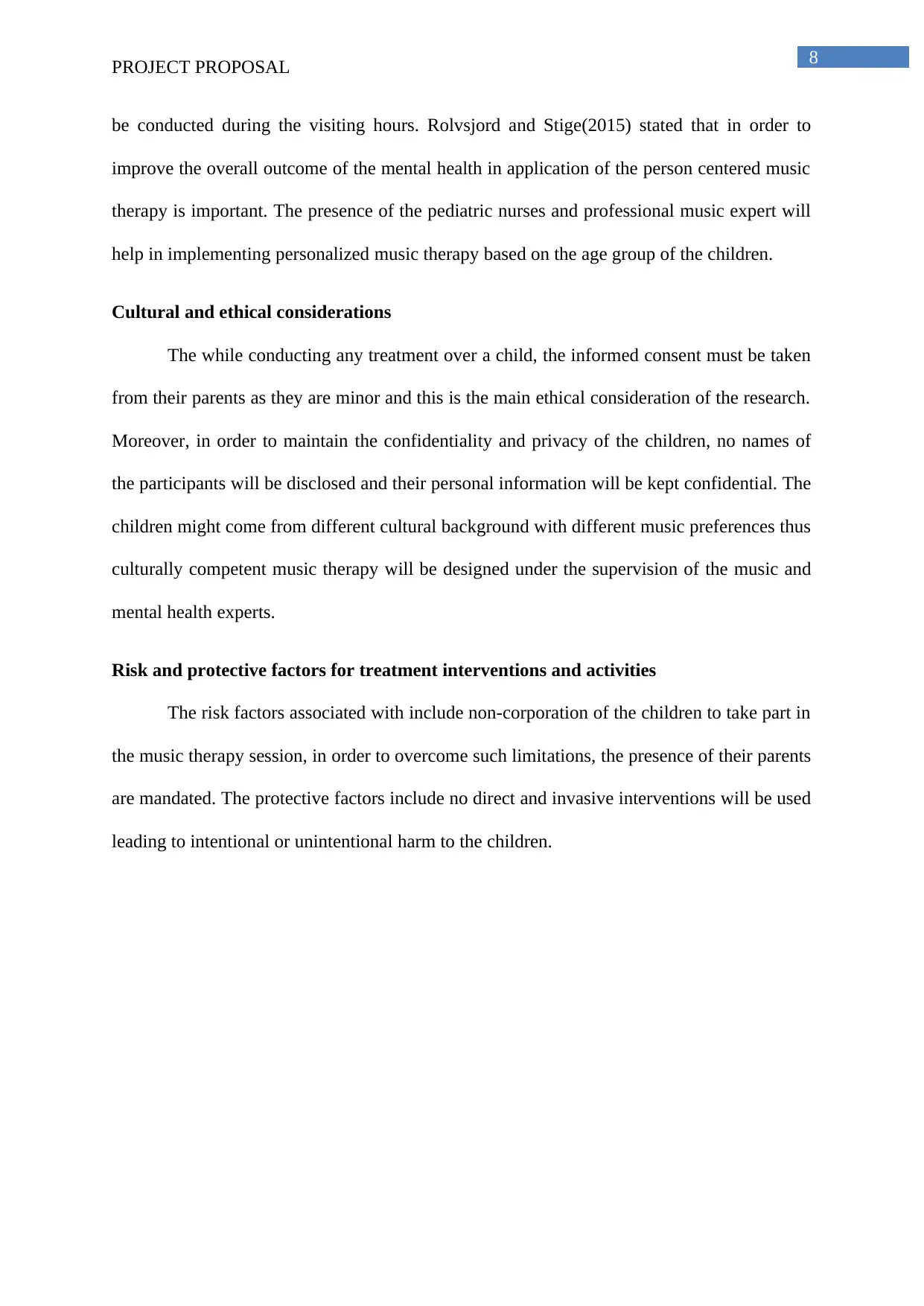
8
PROJECT PROPOSAL
be conducted during the visiting hours. Rolvsjord and Stige(2015) stated that in order to
improve the overall outcome of the mental health in application of the person centered music
therapy is important. The presence of the pediatric nurses and professional music expert will
help in implementing personalized music therapy based on the age group of the children.
Cultural and ethical considerations
The while conducting any treatment over a child, the informed consent must be taken
from their parents as they are minor and this is the main ethical consideration of the research.
Moreover, in order to maintain the confidentiality and privacy of the children, no names of
the participants will be disclosed and their personal information will be kept confidential. The
children might come from different cultural background with different music preferences thus
culturally competent music therapy will be designed under the supervision of the music and
mental health experts.
Risk and protective factors for treatment interventions and activities
The risk factors associated with include non-corporation of the children to take part in
the music therapy session, in order to overcome such limitations, the presence of their parents
are mandated. The protective factors include no direct and invasive interventions will be used
leading to intentional or unintentional harm to the children.
PROJECT PROPOSAL
be conducted during the visiting hours. Rolvsjord and Stige(2015) stated that in order to
improve the overall outcome of the mental health in application of the person centered music
therapy is important. The presence of the pediatric nurses and professional music expert will
help in implementing personalized music therapy based on the age group of the children.
Cultural and ethical considerations
The while conducting any treatment over a child, the informed consent must be taken
from their parents as they are minor and this is the main ethical consideration of the research.
Moreover, in order to maintain the confidentiality and privacy of the children, no names of
the participants will be disclosed and their personal information will be kept confidential. The
children might come from different cultural background with different music preferences thus
culturally competent music therapy will be designed under the supervision of the music and
mental health experts.
Risk and protective factors for treatment interventions and activities
The risk factors associated with include non-corporation of the children to take part in
the music therapy session, in order to overcome such limitations, the presence of their parents
are mandated. The protective factors include no direct and invasive interventions will be used
leading to intentional or unintentional harm to the children.
⊘ This is a preview!⊘
Do you want full access?
Subscribe today to unlock all pages.

Trusted by 1+ million students worldwide
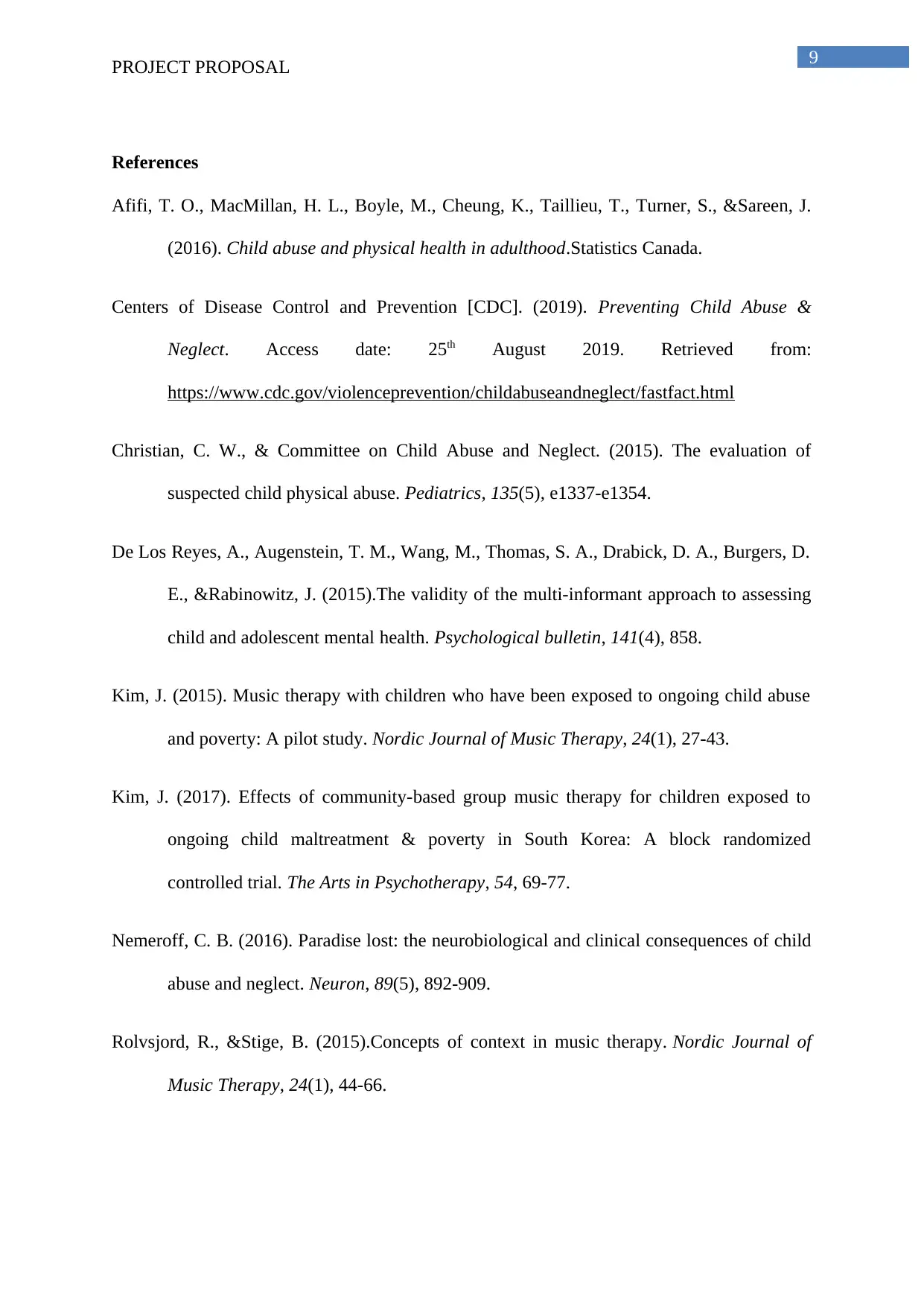
9
PROJECT PROPOSAL
References
Afifi, T. O., MacMillan, H. L., Boyle, M., Cheung, K., Taillieu, T., Turner, S., &Sareen, J.
(2016). Child abuse and physical health in adulthood.Statistics Canada.
Centers of Disease Control and Prevention [CDC]. (2019). Preventing Child Abuse &
Neglect. Access date: 25th August 2019. Retrieved from:
https://www.cdc.gov/violenceprevention/childabuseandneglect/fastfact.html
Christian, C. W., & Committee on Child Abuse and Neglect. (2015). The evaluation of
suspected child physical abuse. Pediatrics, 135(5), e1337-e1354.
De Los Reyes, A., Augenstein, T. M., Wang, M., Thomas, S. A., Drabick, D. A., Burgers, D.
E., &Rabinowitz, J. (2015).The validity of the multi-informant approach to assessing
child and adolescent mental health. Psychological bulletin, 141(4), 858.
Kim, J. (2015). Music therapy with children who have been exposed to ongoing child abuse
and poverty: A pilot study. Nordic Journal of Music Therapy, 24(1), 27-43.
Kim, J. (2017). Effects of community-based group music therapy for children exposed to
ongoing child maltreatment & poverty in South Korea: A block randomized
controlled trial. The Arts in Psychotherapy, 54, 69-77.
Nemeroff, C. B. (2016). Paradise lost: the neurobiological and clinical consequences of child
abuse and neglect. Neuron, 89(5), 892-909.
Rolvsjord, R., &Stige, B. (2015).Concepts of context in music therapy. Nordic Journal of
Music Therapy, 24(1), 44-66.
PROJECT PROPOSAL
References
Afifi, T. O., MacMillan, H. L., Boyle, M., Cheung, K., Taillieu, T., Turner, S., &Sareen, J.
(2016). Child abuse and physical health in adulthood.Statistics Canada.
Centers of Disease Control and Prevention [CDC]. (2019). Preventing Child Abuse &
Neglect. Access date: 25th August 2019. Retrieved from:
https://www.cdc.gov/violenceprevention/childabuseandneglect/fastfact.html
Christian, C. W., & Committee on Child Abuse and Neglect. (2015). The evaluation of
suspected child physical abuse. Pediatrics, 135(5), e1337-e1354.
De Los Reyes, A., Augenstein, T. M., Wang, M., Thomas, S. A., Drabick, D. A., Burgers, D.
E., &Rabinowitz, J. (2015).The validity of the multi-informant approach to assessing
child and adolescent mental health. Psychological bulletin, 141(4), 858.
Kim, J. (2015). Music therapy with children who have been exposed to ongoing child abuse
and poverty: A pilot study. Nordic Journal of Music Therapy, 24(1), 27-43.
Kim, J. (2017). Effects of community-based group music therapy for children exposed to
ongoing child maltreatment & poverty in South Korea: A block randomized
controlled trial. The Arts in Psychotherapy, 54, 69-77.
Nemeroff, C. B. (2016). Paradise lost: the neurobiological and clinical consequences of child
abuse and neglect. Neuron, 89(5), 892-909.
Rolvsjord, R., &Stige, B. (2015).Concepts of context in music therapy. Nordic Journal of
Music Therapy, 24(1), 44-66.
Paraphrase This Document
Need a fresh take? Get an instant paraphrase of this document with our AI Paraphraser
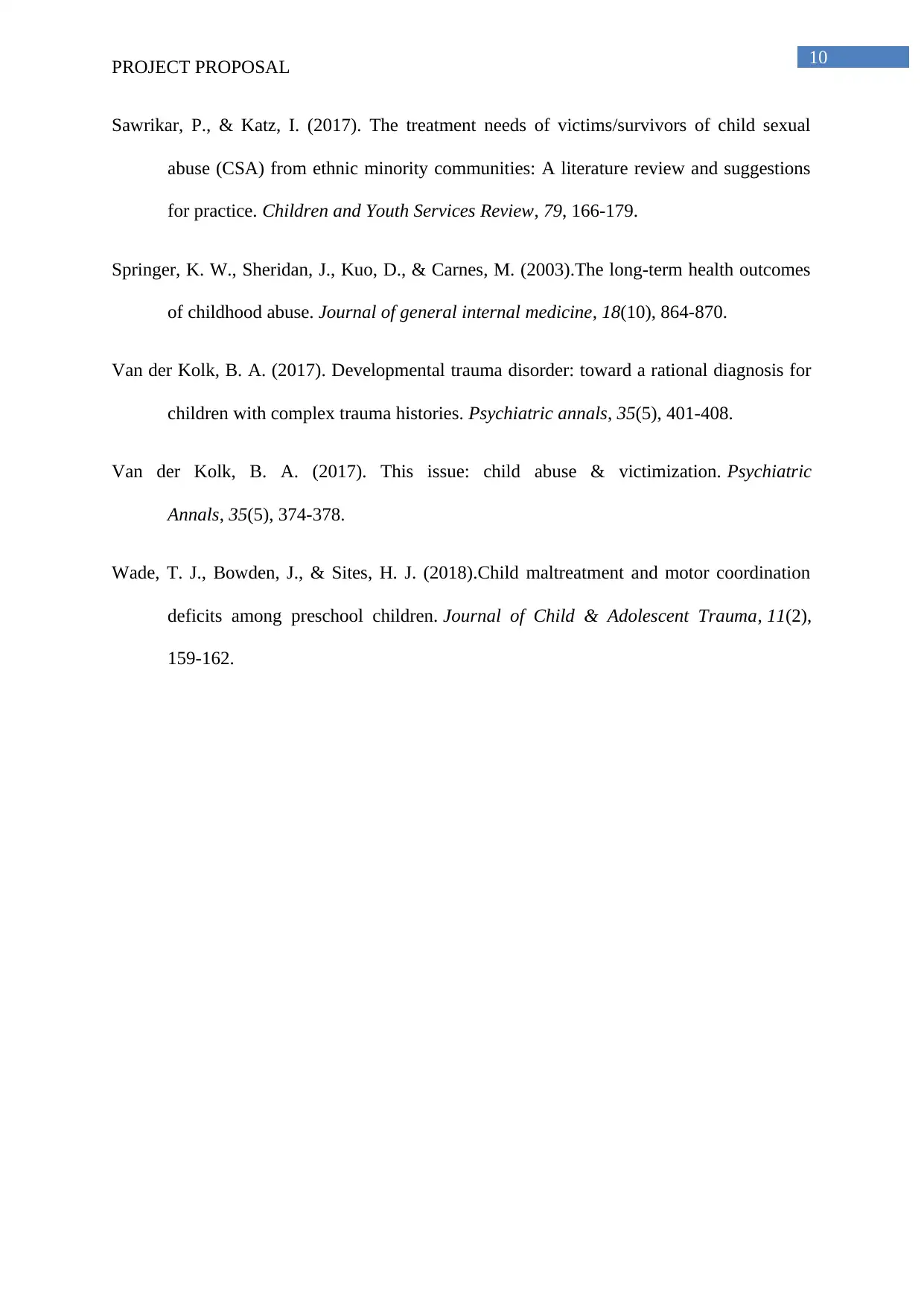
10
PROJECT PROPOSAL
Sawrikar, P., & Katz, I. (2017). The treatment needs of victims/survivors of child sexual
abuse (CSA) from ethnic minority communities: A literature review and suggestions
for practice. Children and Youth Services Review, 79, 166-179.
Springer, K. W., Sheridan, J., Kuo, D., & Carnes, M. (2003).The long-term health outcomes
of childhood abuse. Journal of general internal medicine, 18(10), 864-870.
Van der Kolk, B. A. (2017). Developmental trauma disorder: toward a rational diagnosis for
children with complex trauma histories. Psychiatric annals, 35(5), 401-408.
Van der Kolk, B. A. (2017). This issue: child abuse & victimization. Psychiatric
Annals, 35(5), 374-378.
Wade, T. J., Bowden, J., & Sites, H. J. (2018).Child maltreatment and motor coordination
deficits among preschool children. Journal of Child & Adolescent Trauma, 11(2),
159-162.
PROJECT PROPOSAL
Sawrikar, P., & Katz, I. (2017). The treatment needs of victims/survivors of child sexual
abuse (CSA) from ethnic minority communities: A literature review and suggestions
for practice. Children and Youth Services Review, 79, 166-179.
Springer, K. W., Sheridan, J., Kuo, D., & Carnes, M. (2003).The long-term health outcomes
of childhood abuse. Journal of general internal medicine, 18(10), 864-870.
Van der Kolk, B. A. (2017). Developmental trauma disorder: toward a rational diagnosis for
children with complex trauma histories. Psychiatric annals, 35(5), 401-408.
Van der Kolk, B. A. (2017). This issue: child abuse & victimization. Psychiatric
Annals, 35(5), 374-378.
Wade, T. J., Bowden, J., & Sites, H. J. (2018).Child maltreatment and motor coordination
deficits among preschool children. Journal of Child & Adolescent Trauma, 11(2),
159-162.

11
PROJECT PROPOSAL
PROJECT PROPOSAL
⊘ This is a preview!⊘
Do you want full access?
Subscribe today to unlock all pages.

Trusted by 1+ million students worldwide
1 out of 12
Related Documents
Your All-in-One AI-Powered Toolkit for Academic Success.
+13062052269
info@desklib.com
Available 24*7 on WhatsApp / Email
![[object Object]](/_next/static/media/star-bottom.7253800d.svg)
Unlock your academic potential
Copyright © 2020–2025 A2Z Services. All Rights Reserved. Developed and managed by ZUCOL.




